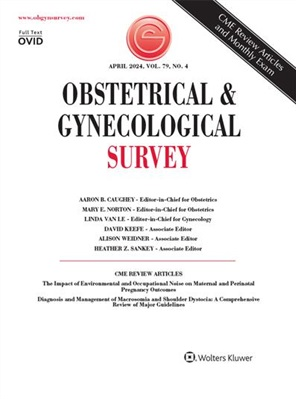DNA Methylation Testing for Endometrial Cancer Detection in Urine, Cervicovaginal Self-Samples and Cervical Scrapes
IF 4.3
4区 医学
Q1 OBSTETRICS & GYNECOLOGY
引用次数: 0
Abstract
ABSTRACT Endometrial cancer is the sixth most common cancer in women globally and has a rising incidence, accounting for 417,000 new diagnoses and more than 97,000 deaths in 2020. Early detection is critical because of a poor advanced-stage prognosis and high relapse risk. Postmenopausal bleeding precedes endometrial cancer in 90% of cases, yet only 5% to 10% of patients with this symptom have an underlying malignancy. Recent cytology research has demonstrated endometrial cancer cells in vaginal samples, suggesting urine and cervicovaginal self-samples may allow convenient and minimally invasive screening. In addition, screening samples for DNA methylation in tumor suppressor genes can increase testing efficacy of triaging patients with postmenopausal bleeding as it does not require intact tumor cells. This study aimed to evaluate the diagnostic performance of endometrial cancer detection using DNA methylation analysis in paired urine, cervicovaginal self-samples, and clinician-taken cervical scrapes. Paired samples from participants of the SOLUTION1 study with endometrial cancer were collected between October 2016 and August 2020. A complete urine void and cervicovaginal self-sample was collected at home, whereas the cervical scrape was taken by a clinician in the operating room before surgery. Each patient had a paired urine, cervicovaginal self-sample, and clinician-taken cervical scrape available for methylation analysis. Controls were collected from the Urine Controls (URIC) biobank and Dutch national cervical cancer screening program. Promoter hypermethylation of the ADCYAP1 , BHLHE22 , CDH13 , CDO1 , GALR1 , GHSR , HAND2 , SST , and ZIC1 genes was tested using quantitative methylation-specific polymerase chain reaction. Optimal 3-marker combinations were determined for each sample type using multivariable logistic regression analysis, and diagnostic performances of each marker and 3-marker panels were assessed by leave-one-out cross validation. A total of 103 endometrial cancer patients were included in this study, with 317 unpaired samples of control women. Methylation levels of all markers were significantly higher in all 3 sample types of endometrial cancer patients compared with healthy control women. In urine, the non–cross-validated area under the curve of the DNA methylation markers ranged between 0.61 and 0.93, in cervicovaginal self-samples between 0.62 and 0.91, and in clinician-taken cervical scrapes between 0.61 and 0.95. Most markers (7/9) showed the highest performance in urine, with the remaining 2 showing best performance in clinician-taken cervical scrapes. The optimal 3-marker combination panels showed area under the curve values of 0.95 (05% confidence interval [CI], 0.92–0.98) for urine, 0.94 (95% CI, 0.90–0.97) for cervicovaginal self-samples, and 0.97 (95% CI, 0.96–0.99) for clinician-taken cervical scrapes. The sensitivity and specificity of the optimal urine testing panel were both 90%, were 89% sensitivity and 92% specificity for cervicovaginal self-samples, and were 93% sensitivity and 90% specificity for clinician-taken cervical scrapes. The leave-one-out cross-validation analysis revealed virtually equal performances in marker panels for each of the 3 testing modalities. The results of this study demonstrate high diagnostic potential of DNA methylation testing in minimally and noninvasive samples for endometrial cancer detection, emphasizing the potential for patient-friendly home-based sample collection.DNA甲基化检测在尿液、宫颈阴道自身样本和宫颈刮擦中检测子宫内膜癌
子宫内膜癌是全球第六大最常见的女性癌症,并且发病率呈上升趋势,到2020年,子宫内膜癌新诊断病例为41.7万例,死亡病例超过9.7万例。早期发现至关重要,因为晚期预后差,复发风险高。绝经后出血在90%的病例中先于子宫内膜癌,但只有5%至10%的患者有这种症状有潜在的恶性肿瘤。最近的细胞学研究表明阴道样本中存在子宫内膜癌细胞,这表明尿液和宫颈阴道自身样本可以方便地进行微创筛查。此外,筛选肿瘤抑制基因的DNA甲基化样本可以提高绝经后出血患者的检测效率,因为它不需要完整的肿瘤细胞。本研究旨在评估使用配对尿液、宫颈阴道自身样本和临床采集的宫颈刮痕DNA甲基化分析检测子宫内膜癌的诊断性能。在2016年10月至2020年8月期间收集了SOLUTION1研究中患有子宫内膜癌的参与者的配对样本。在家中收集完整的尿空和宫颈阴道自我样本,而术前由临床医生在手术室进行宫颈刮拭。每位患者都有配对尿液、宫颈阴道自我样本和临床采集的宫颈刮拭可用于甲基化分析。对照组来自尿液对照生物库和荷兰国家宫颈癌筛查项目。采用定量甲基化特异性聚合酶链反应检测ADCYAP1、BHLHE22、CDH13、CDO1、GALR1、GHSR、HAND2、SST和ZIC1基因的启动子超甲基化。采用多变量logistic回归分析确定每种样本类型的最佳3标记组合,并通过留一交叉验证评估每种标记和3标记面板的诊断性能。本研究共纳入103名子宫内膜癌患者,317名未配对的对照女性样本。与健康对照女性相比,所有3种类型的子宫内膜癌患者中所有标记物的甲基化水平均显著升高。在尿液中,DNA甲基化标记曲线下的非交叉验证面积在0.61至0.93之间,在宫颈阴道自身样本中在0.62至0.91之间,在临床采集的宫颈刮痕中在0.61至0.95之间。大多数标记物(7/9)在尿液中表现最佳,其余2种标记物在临床采集的宫颈刮痕中表现最佳。最佳的3个标记组合组显示,尿液的曲线下面积为0.95(05%置信区间[CI], 0.92-0.98),宫颈阴道自身样本的曲线下面积为0.94 (95% CI, 0.90-0.97),临床采集的宫颈刮擦的曲线下面积为0.97 (95% CI, 0.96-0.99)。最优尿检组对宫颈阴道自身标本的敏感性和特异性分别为90%、89%和92%,对临床采集的宫颈刮痕标本的敏感性和特异性分别为93%和90%。留一交叉验证分析揭示了几乎相等的性能在标记面板为每一个3测试模式。本研究的结果表明,DNA甲基化检测在子宫内膜癌的微创和无创性检测中具有很高的诊断潜力,强调了患者友好的家庭样本收集的潜力。
本文章由计算机程序翻译,如有差异,请以英文原文为准。
求助全文
约1分钟内获得全文
求助全文
来源期刊
CiteScore
2.70
自引率
3.20%
发文量
245
审稿时长
>12 weeks
期刊介绍:
Each monthly issue of Obstetrical & Gynecological Survey presents summaries of the most timely and clinically relevant research being published worldwide. These concise, easy-to-read summaries provide expert insight into how to apply the latest research to patient care. The accompanying editorial commentary puts the studies into perspective and supplies authoritative guidance. The result is a valuable, time-saving resource for busy clinicians.

 求助内容:
求助内容: 应助结果提醒方式:
应助结果提醒方式:


